How to choose the best Gmail client: Top 5 picks!
For most of us, Gmail is the go-to platform for managing everyday emails. The reason? Its default interface is straightforward and something we’re used to. Still, it doesn’t always offer the level of customization or advanced efficiency and automation features we need, which can hurt productivity.
That’s where Gmail clients come in.
The right email client can help you organize your workflow and boost efficiency with modern email management and AI-native features. Some solutions today can automatically generate context-rich responses and even entire emails, so you have a leg up on your day. The only problem is that there are tons of Gmail clients out there—so, how do you find something that’s perfect for you?
In this article, we’ll discuss the best Gmail clients available. We’ll go over:
The benefits of using a Gmail client
Tips to find a suitable solution
Top five options for a Gmail client in 2025
Email client for Gmail—An overview
Gmail clients are powerful third-party apps that help users access, manage, and interact with their Gmail accounts outside of the primary web interface. But if Gmail’s web client already works fine, why even switch to a third-party service?
Because you’d be missing out on a new era of email efficiency supported by major new functionalities, features, and automation. Third-party clients go beyond convenience—they introduce productivity-boosting features like automation and deeper customization, often AI-assisted, that Gmail simply doesn’t offer. Let’s see how both options differ:
Web-based Gmail client: It is the default interface, accessible through any web browser. It provides a fully integrated Gmail experience and access to all the features Gmail offers, including email organizations, Google Drive integration, etc., though that’s where it also falls short. The web-based Gmail client doesn’t go beyond basic interface and organization on its own and doesn’t offer deep integration with other productivity tools.
Third-party email clients: These applications offer additional features, such as better customization, multi-account management, and integration with other work tools to support Gmail accounts. Some email clients are designed with power users in mind, and come equipped with advanced features like smart inbox organization and automated task management that help handle emails efficiently. The main reason users choose these applications is to have a more intelligent and tailored email management experience, as well as enjoy greater control over their inbox and workflow.
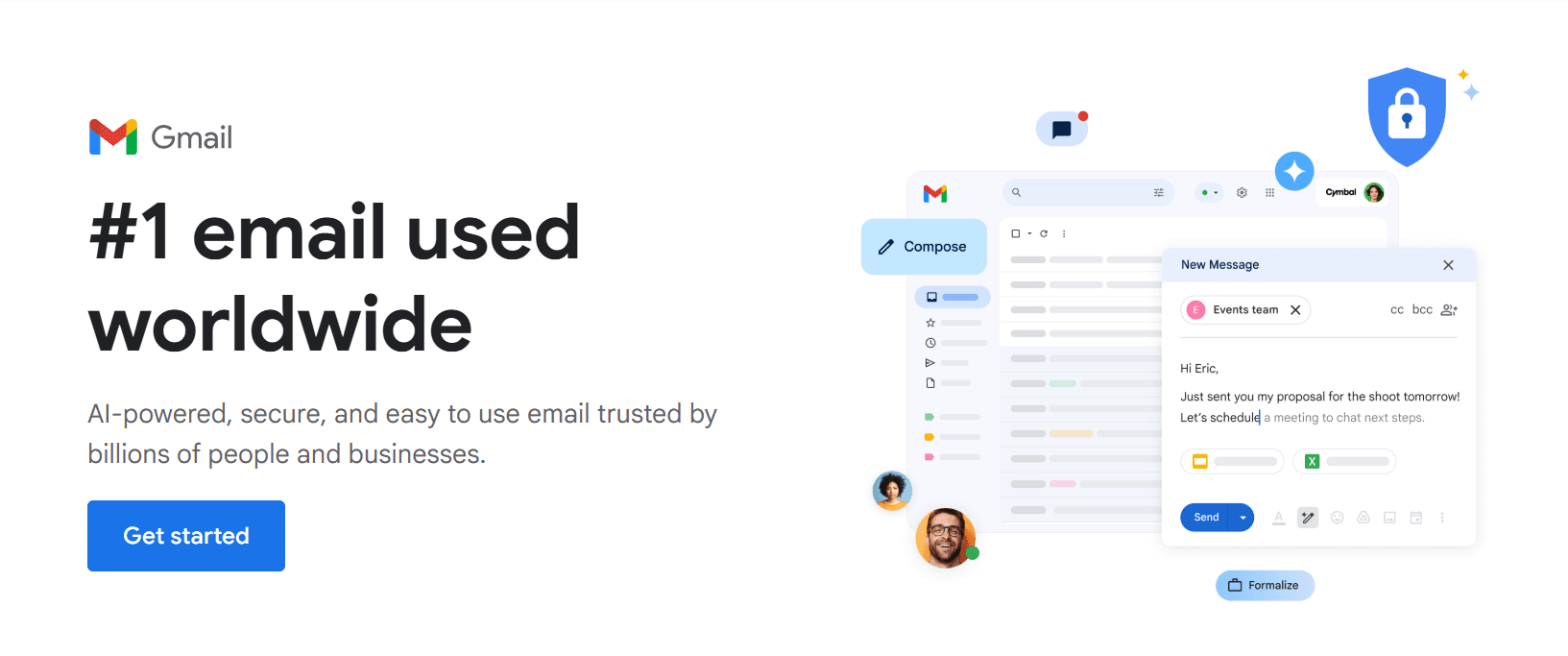
5 benefits of using Gmail email clients
Choosing a third-party Gmail client instead of its standard web-based option comes with numerous benefits that Gmail lacks on its own. Here are five key advantages:
Clutter-free organization: Many email clients use AI and automation to sort, categorize, and filter messages based on patterns or prompts, making it easier to manage large volumes of emails. You can automatically archive unwanted emails, prioritize key messages, and send automated follow-ups and reminders. Both businesses and productivity enthusiasts find this particularly useful as it saves time and enhances visibility for important communications.
Offline access to emails: Most third-party clients offer access to your email, regardless of whether you’re online or offline. Once the application downloads your emails onto your device, you can access them at any time and any place, giving you extra flexibility.
AI-powered efficiency: Some email clients integrate AI-assisted predictive typing, smart responses, and other quick actions to reduce manual effort and help you get more done—faster. The best options even offer calendar management features to help sync team-wide schedules.
Seamless integration: Most Gmail clients offer more integrations than the default interface. This enables you to connect with a variety of other productivity tools and apps, such as calendars, task managers, cloud storage services, etc.
Multiple email account management: A third-party email client allows you to manage multiple Gmail accounts from one dashboard. You don’t have to worry about scattered log-ins and can even perform actions like smart filtering (to get rid of those pesky promotions), multiple-account search, and custom notifications.
What makes a good email client for Gmail: Factors to consider
When choosing a Gmail client, you should factor in your needs and preferences, as much as the more general factors that make an email client a great tool, to make an informed decision. Some of the key factors include the following:
Speed and performance | One of the most talked about and criticized aspects of the default Gmail interface is its speed—or the lack of it. A slow-to-load or refresh inbox costs you time, so you’ll want a client with snappy navigation features designed for a fast and distraction-free experience. |
Advanced organization tools | You’ll want smart organizational tools like intelligent folders or auto-sorting labels to simplify information retrieval and keep your inbox under control—this makes a huge difference if you’re juggling multiple communication channels throughout the day. |
Interface and shortcuts | If there’s one thing users really appreciate in an email client, it’s a customizable interface. A good Gmail client should give you the flexibility to make it your own, which can greatly improve your email experience. It should let you set up custom keyboard shortcuts and commands, as well as adjust the layout and appearance of your inbox to match your preferences. |
AI-powered email management features | The most impressive email clients today use AI and automation to enhance email management and free up your time for other cognitive tasks. You should look for a Gmail client that offers AI-assisted features like automated response suggestions and reminders to help you stay on top of your day. |
Best email client for Gmail—5 options reviewed
We’ve seen numerous Gmail clients on the market—some known for their advanced features while others for their customizable UIs. We singled out the following five as the best email clients for Gmail worth trying out:
Apple Mail
Microsoft Outlook
Thunderbird
eM Client
Notion Mail
1. Apple Mail
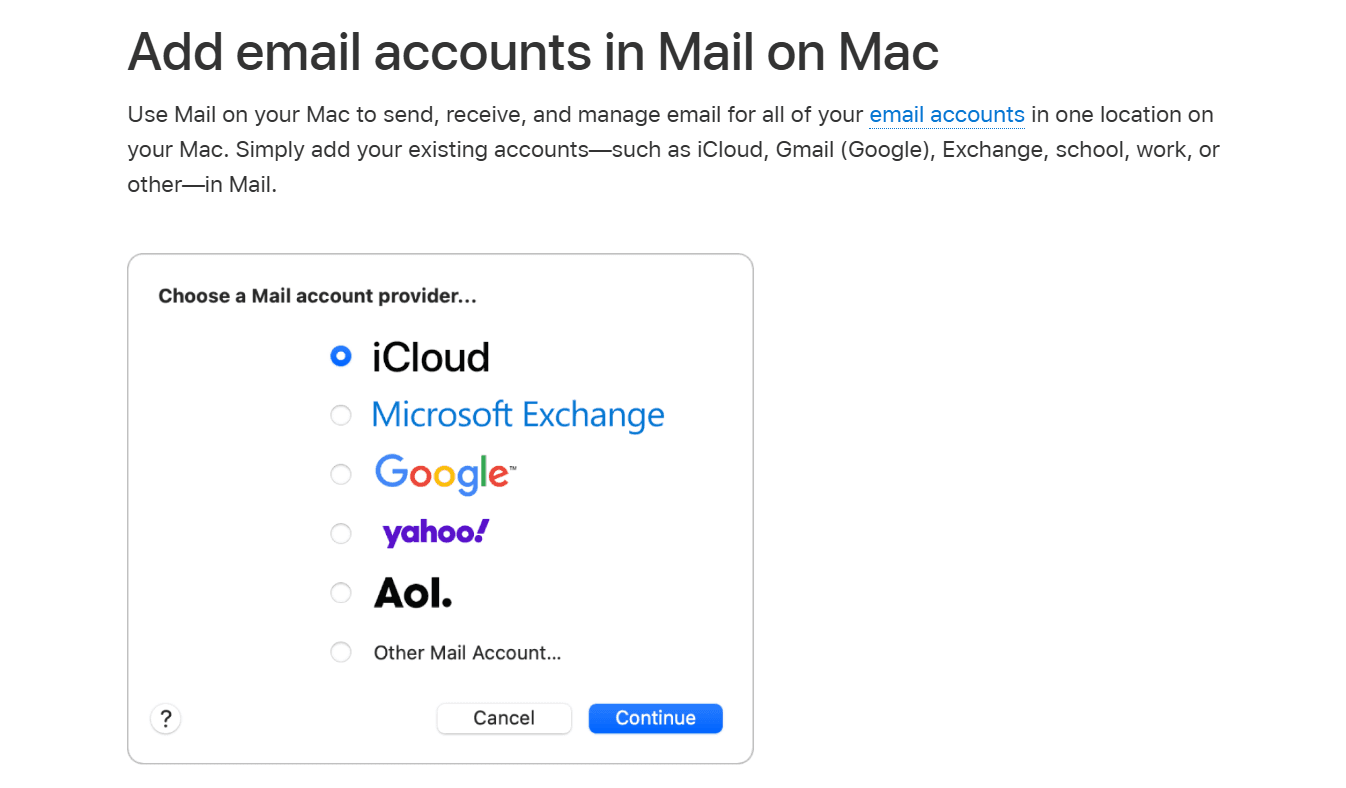
If you’re looking for a simple but effective Gmail client, Apple Mail is a solid alternative to Gmail, especially if you’re already in the Apple ecosystem. Its seamless integration with macOS and iOS helps you enjoy a clean and user-friendly interface and access folders, accounts, and mailboxes via the sidebar. While it isn’t known for its AI features, Apple Mail does offer some handy tools powered by their recently introduced Apple Intelligence to help users save time on basic tasks. These include highlighting urgent emails with Priority Messages, offering quick, generated responses with Smart Replies, and assisting users in crafting messages with Writing Tools for grammar and style suggestions.
If organization is your biggest concern, you’ll probably love Apple Mail’s unified mailboxes that let you see your draft, sent, and incoming emails in a single list. However, this feature might not be for you if you have to maintain multiple communication channels as it can quickly get overwhelming.
While the simplicity of Apple Mail’s user interface may appeal to some, those interested in personalization will probably be disappointed by the lack of advanced customization options.
Compatibility with other platforms is another aspect where Apple Mail falls short. Unlike most other email clients on our list, Apple Mail is only available on Apple devices—iPads, iPhones, and Mac computers.
Pricing
As a built-in email client that’s available on all Apple iOS and macOS operating systems, Apple Mail is free of charge, and there is no paid version. This also means that it’s not available for users outside the Apple ecosystem as it’s not sold separately.
Pros and cons
Browse the table below for a short comparison of Apple Mail’s advantages and downsides:
Pros | Cons |
Minimalistic, user-friendly interface Offers Apple Intelligence features Pre-installed on Apple devices Offers unified mailboxes Free of charge | Lack of personalization features Available for Apple users only |
2. Microsoft Outlook
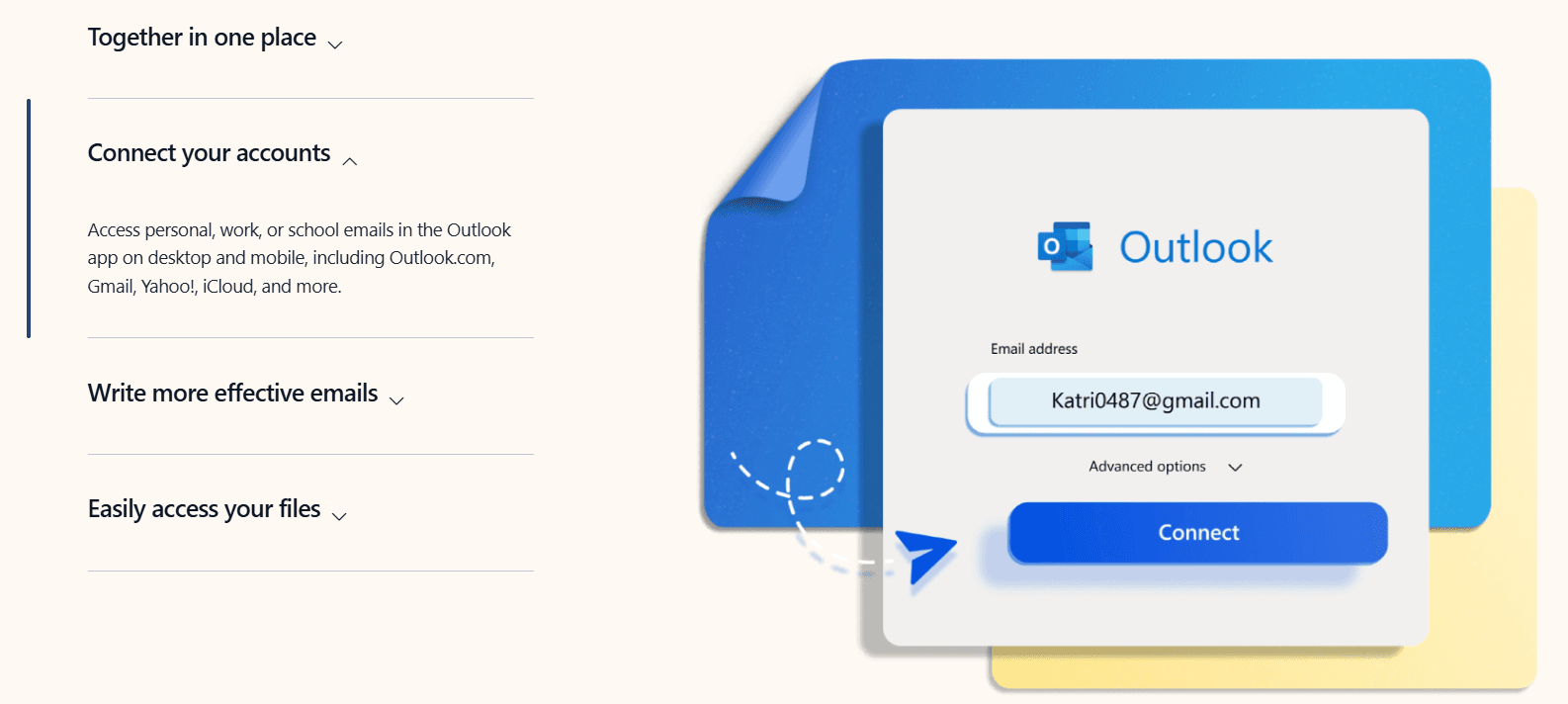
Microsoft Outlook is a popular and versatile email client that works with Gmail, among other email services and apps.
Much like Gmail, Outlook emphasizes functionality rather than aesthetics, offering a pretty basic interface—though you can customize the theme by choosing different fonts and colors. The platform lets you set up unlimited inboxes, displayed in a list on the side, as well as customize the order. For all its “function over form” approach, Outlook’s user interface may appear cluttered, and the lack of organization (e.g., the panels displaying various icons and buttons) makes it difficult to navigate.
You can also enjoy some AI-powered customization and productivity features like:
Focused inbox: Automatically prioritizes important emails, so you don’t miss key messages
Smart search: Lets you look up emails fast using keywords and powerful filters
Mention: Notifies you when someone tags you in an email
It’s worth noting, however, that many users report slower performance as a result of some AI processes in Outlook, which can be resolved by disabling the AI service.
Unlike Apple Mail, Outlook is available for download and use on different devices and operating systems, making it more versatile. As part of the Microsoft Office Suite, Outlook offers seamless integration with tools like Word, Excel, and PowerPoint.
Pricing
Outlook is included in the Microsoft Office Suite, and it’s free of charge. Other than the free plan, the platform offers the following three paid options:
Home
Microsoft Personal: $99.99 per year
Microsoft Family: $129.99 per year
Business
Basic: $6/user per month
Standard: $12.50/user per month
Premium: $22/user per month
Microsoft 365 Apps: $8.25/user per month
Enterprise
Microsoft 365 F3: $8/user per month
Microsoft 365 E3: $33.75/user per month
Microsoft 365 E5: $54.75/user per month
Note: All prices reflect annual subscription values.
Pros and cons
Consult the table below for an overview of Outlook’s advantages and downsides:
Pros | Cons |
Customization options Unlimited inboxes Compatibility with different devices and operating systems Customization and productivity features Microsoft Office Suite integrations Free plan | Cluttered interface Limited organization options Reported slower performance as inboxes expand |
Keep reading: Struggling with removing an Outlook account from your iPhone? Read our guide to find the answers.
3. Thunderbird
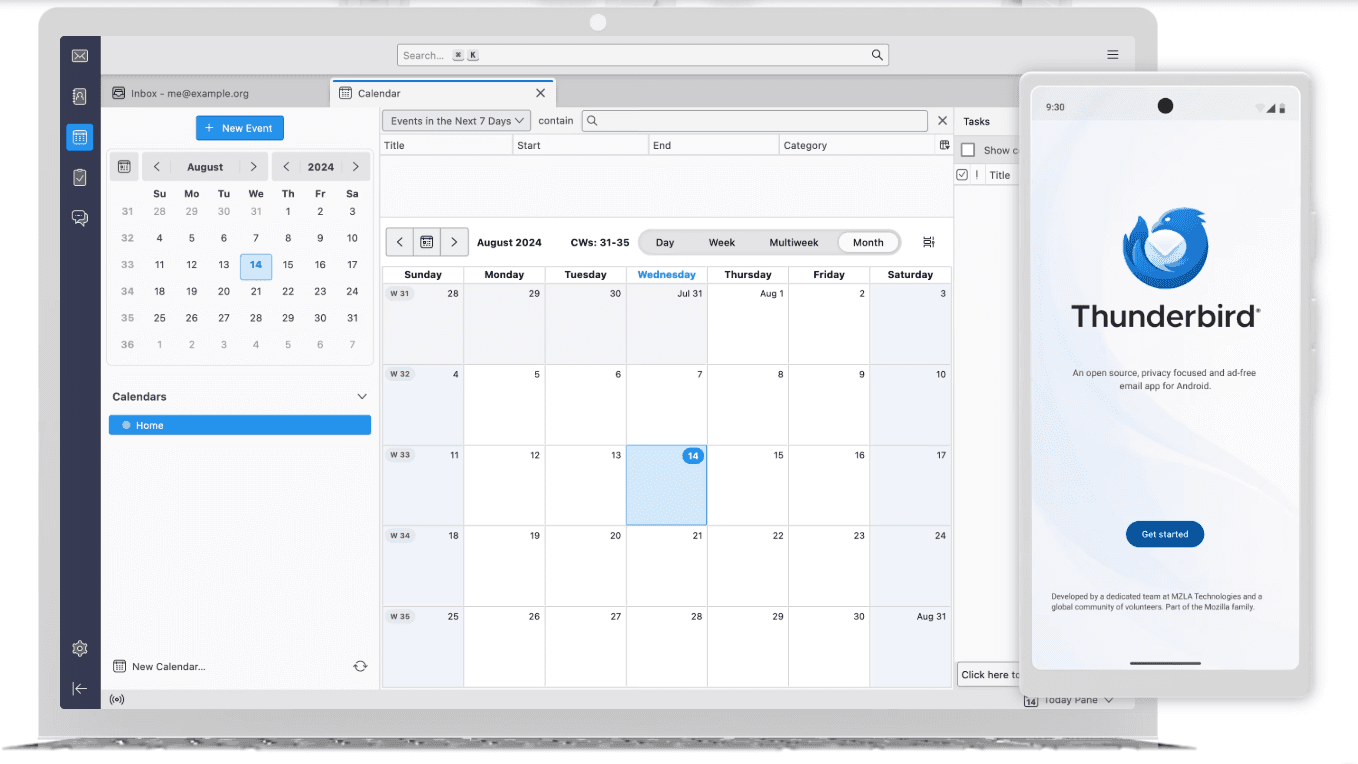
Mozilla Thunderbird, or just Thunderbird, is a versatile, open-source email client that offers a wide range of features and customization options, making it a top choice for Gmail users.
One of the platform’s biggest strengths is its vast catalog of add-ons—from scheduling or tracking sent emails to customizing your inbox with smart templates, Thunderbird provides nearly endless possibilities for personalization. Most of the add-ons are free, although premium features, such as smart templates, do come at a cost.
ThunderAI, the platform’s recent addition, integrates ChatGPT into the platform, giving users access to AI-powered email assistance free of charge. It’s also worth noting that the platform allows you to choose where to store your emails.
While Thunderbird’s interface is functional, it may feel somewhat dated, especially when compared to modern designs like Windows 11. The tabular navigation system, borrowed from Firefox, works well, though it’s more focused on functionality than design. Still, there are plenty of themes available, allowing you to tailor your experience.
When it comes to performance, the platform is pretty fast and efficient, with quick syncing and near-instant email sending. However, if you have slower connections or large attachments, you might experience some lag.
Pricing
Other than premium features, such as smart templates, Thunderbird is completely free to use. However, if you want to support this open-source email client, there is an option to donate money—all the funds go to the upkeep and development of the platform.
Pros and cons
Here’s a summary of Thunderbird’s positive and negative aspects:
Pros | Cons |
Rich customization options and add-ons Free to use Constantly updated Fairly quick | Slightly outdated interface Potential lagging with slower connection and larger attachments |
4. eM Client
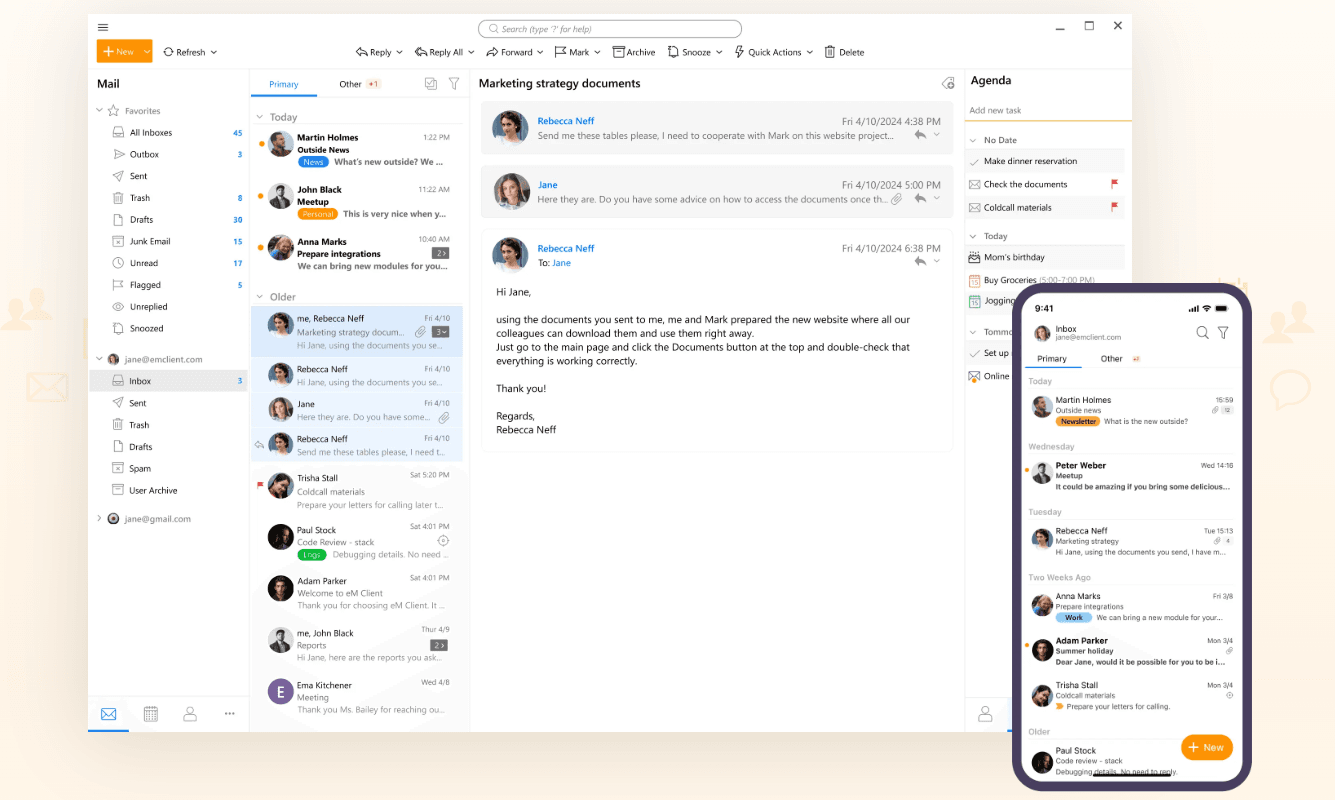
eM Client is known for its user-friendly design and excellent Gmail integration. It’s a highly versatile platform that supports a wide range of technologies and offers a plethora of features, some of which are:
Attachments view that allows you to search and manage email attachments easily, helping you to free up cluttered storage space
Watch for reply feature that ensures you never miss an important email response
Snooze feature that helps you focus on essential tasks by postponing emails that are less urgent
Robust task and calendar management features that allow you to create tasks, events, and reminders directly within the app
eM Client uses generative AI tools powered by ChatGPT for creating, rephrasing, and proofreading emails. These tools are available even with the Free plan. They can only be used with your explicit permission, and you can disable them if you prefer.
Another area where the platform stands out is the customizability of the interface. You can tweak the layout, themes, and appearance to suit your preferences. It also supports offline mode, so you can access and compose emails without an internet connection.
That said, eM Client does fall short in a few areas. For example, the free version is limited to managing only two email accounts, and it’s somewhat restrictive in terms of options—not ideal for power users with more accounts. Additionally, some advanced features, such as email templates and advanced search, are only available in the paid version.
Pricing
You can choose from the following three options:
Free
Personal: €29.95
Business: €158.95
Note: eM Client offers a 30-day free trial and a 30-day money-back guarantee.
Pros and cons
You can revisit where eM Client excels and where it falls short below:
Pros | Cons |
Handy email management features Interface customizability Free plan Free trial and money-back guarantee | Limited free version Certain features available only for paid tiers |
5. Notion Mail
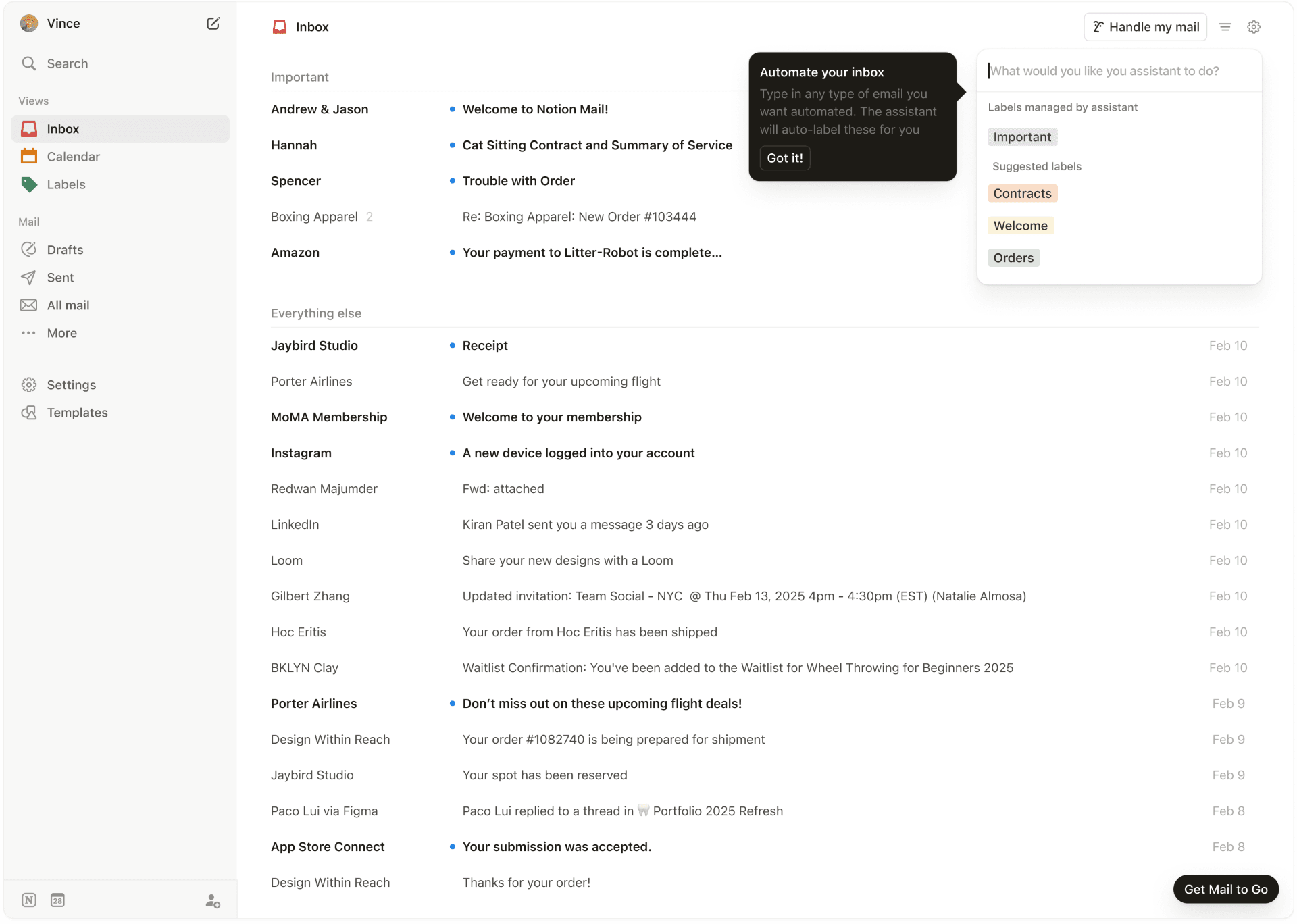
Notion Mail is an AI-native Gmail client that can help you manage all aspects of your inbox without disrupting your workflow. It automatically labels and organizes your emails around your priorities, drafts emails for you, and offers powerful, customizable views that let you build “inboxes within an inbox” to fit your unique workflows. Whether you’re a small business owner, startup founder, productivity enthusiast, or just love organization and planning, Notion Mail is designed to keep you focused and moving. You can access Notion Mail via iOS, Android, and Windows apps.
This free, builder-focused solution is completely integrated within the Notion productivity ecosystem, though you can also use it as a standalone email solution to support organization, scheduling, and everyday project management via simple AI prompts.
The platform comes with a built-in Notion Calendar for fast, conflict-free scheduling for you and your teams. For example, you can use short commands like /schedule or insert a scheduling button, Calendly, via Notion Calendar booking links to align with your team.
One of Notion Mail’s biggest strengths, however, comes from powerful AI and automation capabilities. Notion Mail can organize itself, draft emails for you, and schedule meetings with the click of a button. You get to significantly minimize the time you spend on mundane tasks like responding to emails and decluttering your inbox, leaving you with more time for tasks that drive growth.
Other features that can help you on a daily basis include:
Auto-reply configurations for common scenarios
AI-written responses (smart, personalized AI-generated replies created based on the context of the email)
Quick-access keyboard shortcuts
Quick email summaries
Productivity-first tools like email snippets, notes, emojis, slash commands, mentions, and more
What helps Notion Mail completely upgrade your productivity game is its Custom Views feature. This option allows you to create specific communication sections for different parts of your workflows, from keeping track of project deadlines to coordinating event schedules.
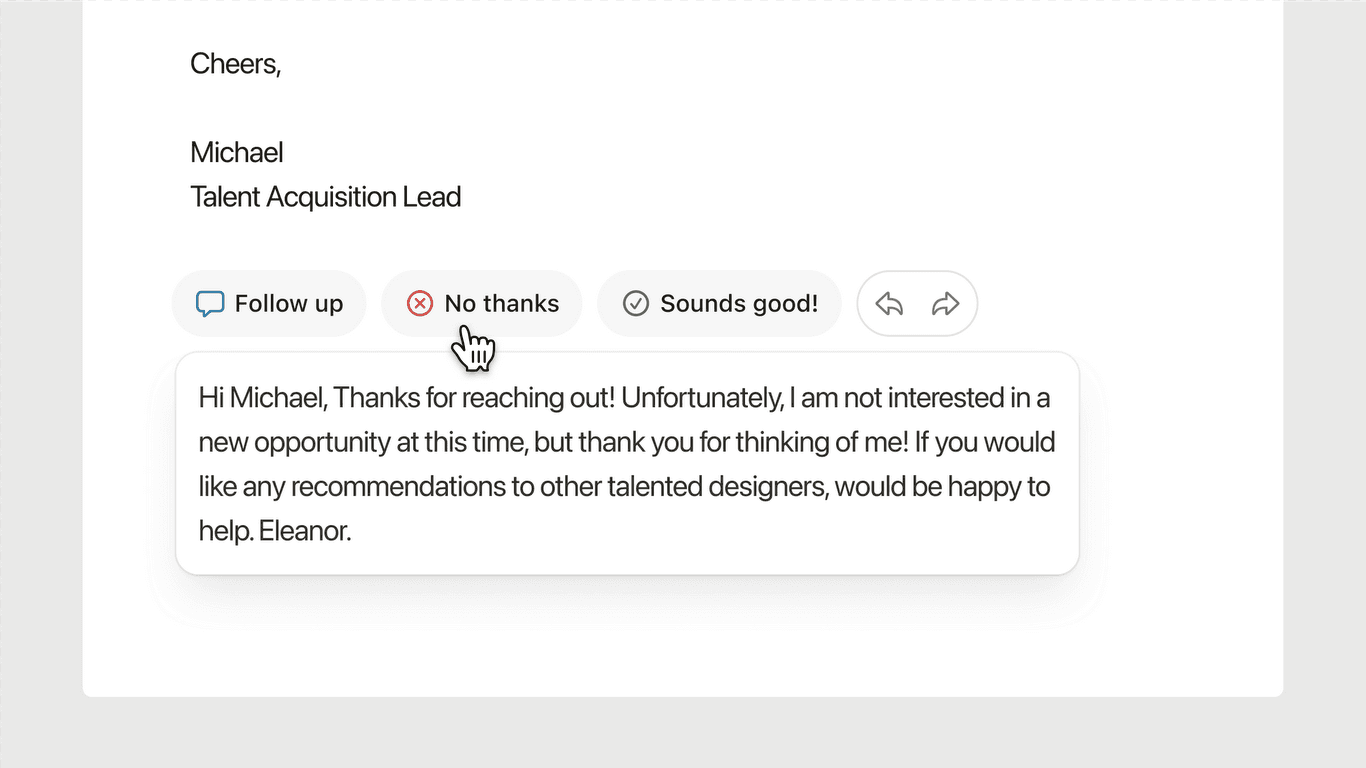
The downsides? Notion Mail is a relatively new product, so there’s a bit of a learning curve with its advanced features. While it might take some time to get used to, once you familiarize yourself with them, these features can significantly save you time and improve productivity. Additionally, the platform only works as a standalone Gmail client—which means you need a Gmail or Google account to get started.
Pricing
Notion Mail is free, and it comes with some basic AI features (as part of Notion’s free offering). To access more advanced generative AI features, you have to purchase the Notion AI add-on.
Pros and cons
The following table summarizes Notion Mail’s benefits and disadvantages:
Pros | Cons |
Free to use AI and automation-boosted productivity Flexible email organization with customizable views AI-powered, prewritten email templates Smart data management, sorting, and scheduling options | A Gmail/Google-only email client A relatively recent addition to the Notion ecosystem |
Sign up for Notion Mail
Getting started with Notion Mail is a breeze! All you need to do is sign up with your Google or Gmail account—and that’s it.
While the email suite already comes with many integrated AI features free of charge, you can also get the Notion AI add-on to access advanced productivity features!
Bonus read: Got more queries? We’ve several email management guides to help you out:
